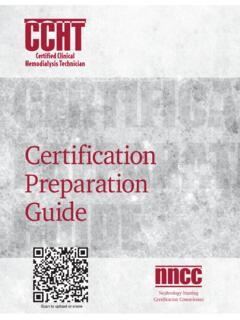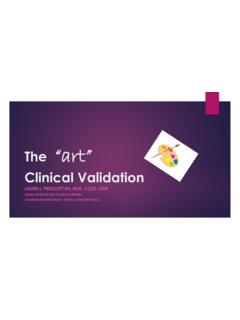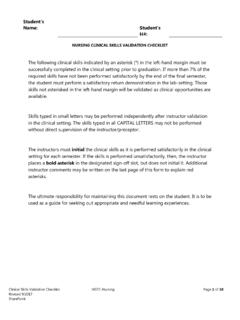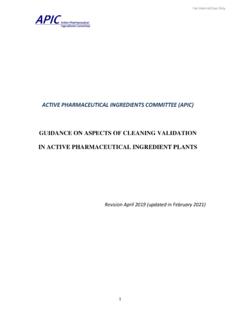Transcription of CTTM08 - Quick Guide Part I - European Medicines Agency
1 Quick Guide Part I How to evaluate a clinical Trial Application: Assessment and Decision CTIS Training Programme Module 08 Version September 2022 Learning Objectives Remember the phases and associated timelines for evaluating an initial clinical trialapplication (CTA). Understand the process and the user roles involved in the Assessment of Part I of aninitial CTA as a Reporting Member State (RMS) and as a Member State Concerned(MSC). Understand the process and the user roles involved in the Assessment of Part II of aninitial CTA as a MSC. Understand the process and the user roles involved in the Decision regarding theauthorisation of an initial CTA. Remember the workload management functionalities in CTIS that allow users tomonitor their tasks during the evaluation of an initial CTA. European Medicines Agency , 2021 Reproduction and/or distribution of the content of these training materials for non-commercial or commercial purposes is authorised, provided the European Medicines Agency is acknowledged as the source of the materials.
2 The European Medicines Agency developed this training material to enhance public access to information on the clinical Trial Information System (CTIS). This material describes a preliminary version of CTIS and may therefore not entirely describe the system as it is at the time of use of this material. The Agency does not warrant or accept any liability in relation to the use (in part or in whole) or the interpretation of the information contained in this training material by third parties. How to evaluate an Initial CTA: Assessment and Decision 2 Record of updated versions The table below describes the updated versions after CTIS go-live (January 2022): Version Version description Date New information related to how to upload documents Not for publication September 2022 Minor changes applied ( tittle, reference links, format, etc.). May 2022 Training material version published at CTIS go-live.
3 September 2021 How to evaluate an Initial CTA: Assessment and Decision 3 Overview of Assessment Part I The assessment of Part I consists of the evaluation of scientific documentation related to the trial on the anticipated therapeutic intend and benefit for public health, potential risks for the subject, compliance with the manufacturing, import, and labelling requirements, amongst other documentation provided in the application dossier. These aspects are to be evaluated during the assessment of Part I and are reflected in the system in the sections displayed on the figure on the right side. The joint review by the Reporting Member State (RMS) and the MSC results in a Final Assessment Report (FAR) prepared by the RMS and in a conclusion for Part I, which will establish if the conduct of a clinical trial is acceptable; acceptable with conditions; or not acceptable.
4 Timelines The assessment of Part I of an Initial application can take up to 45 days, or up to 76 days if Requests for Information (RFIs) are raised. The RMS may also extend the period up to 50 days for consultation with experts1. The dates shown in the figure above (see Annex) correspond to the maximum deadlines foreseen for each task and the maximum timeframes between the end of a task and the end of the following task. However, the system includes a dynamic workflow by which, if a task is completed before its deadline, the corresponding deadlines for the following tasks are recalculated, but the maximum timeframes are still respected. The maximum deadlines foreseen for the tasks related to the assessment of Part I are: For hard tasks (mandatory tasks): o Submit Final Assessment Report (FAR) Part I and conclusion Part I up to 45 days or 76 days (if RFIs are raised), from the validation of the initial CTA.
5 Performed by the RMS. 1 For more information on how to extend the period for consultation with experts refer to the FAQs document of this module. #CTIS insights In the case of multinational trials, Part I part is jointly assessed by all MSCs, but the conclusion is submitted only by the RMS. Assessment Part I The Assessment of Part I consists in determining the acceptability (or not) of conducting a clinical trial from the review of the scientific documentation provided by the sponsor in the application. Figure 1 - Application sections in Part I where an MSC can document considerations How to evaluate an Initial CTA: Assessment and Decision 4 For soft tasks (non-mandatory tasks): o Circulate Draft Assessment Report up to 26 days from the validation of the initial CTA. Performed by the RMS. o Document considerations up to 38 days from the validation of the initial CTA.
6 Performed by the RMS and MSC. o Consolidate considerations up to 7 days after the considerations are shared. Performed by the RMS. o Raise an RFI (if applicable) up to 45 days from the validation of the Initial CTA. Performed by the RMS. o Assess an RFI response up to 12 days after the response is sent by the sponsor for the MSC, and up to 19 days for the RMS. Performed by the RMS and MSC. Process to assess Part I The assessment of Part I starts after the validation of the Initial application is submitted by the RMS. The MSC will receive the following notice: First, the RMS can circulate the Draft Assessment Report (DAR) of Part I among the MSCs. This document includes a preliminary assessment of the scientific documentation of the application dossier. It consists of seven parts: o Introduction. o Quality assessment. o Pre- clinical assessment.
7 O clinical assessment. o Statistical methodological assessment. o Regulatory assessment. o Conclusion. The RMS can upload a separate document for each part of the DAR (see Article 6 of the CT Regulation2). However, it is not mandatory to upload them all. To perform this task, the RMS user with the appropriate role (see section Roles and permissions below) from the RMS needs to follow these steps: 1. Access the Tasks tab and click on the Circulate Draft Assessment Part I report task. The task can be assigned to him/her by a CT Coordinator or if the user has the appropriate role, the user can select Assign to myself . The system will redirect the user automatically to the relevant Evaluation section. 2 Regulation (EU) No 536/2014 of the European Parliament and of the Council on clinical trials on medicinal products for human use, EU Official Journal L158.
8 Available at: Assessment Part I Draft Assessment Report RMS The Draft Assessment Report (DAR) is a preliminary assessment performed the RMS of the scientific documentation of the application dossier. It is circulated to all the MSCs. #CTIS insights The documents of the DAR need to be actively shared by the RMS for the other MSC to view them. If the RMS uploads and shares documents for each of the 7 parts of DAR, the system will automatically deem this task as complete. If not, the RMS user must click on the Complete button in the Tasks tab. How to evaluate an Initial CTA: Assessment and Decision 5 2. Templates for each of the 7 parts of the DAR are available and can be retrieved by selecting the desired DAR part and clicking on the Generate template button (see image below). The document is downloaded on the user s local disk. It contains prepopulated information about the trial.
9 From there, the user can upload the documents in the corresponding part. Finally, users need to click on select all , and then click on the share button. 3. MSC users can have a discussion amongst themselves before submitting the Part I DAR, by using a discussion functionality. In parallel, all MSCs can document their considerations for Part I of the application dossier from the moment the application has been validated. Moreover, MSCs can also document considerations regarding the DAR, up until 12 days after it has been circulated by the RMS. To perform this task MSC users with the appropriate permissions which have been assigned this task (see section Roles and Permissions below) need to follow these steps: 1. Access the Tasks tab and click on the Document Considerations Assess Part I task. The task can be assigned to him/her by a CT Coordinator or if the user has the appropriate role, the user can select Assign to myself.
10 The system will redirect users to the relevant Evaluation section where they can document their considerations. 2. Select the + New button to create a new consideration. Generate template button Share button Add document button Select all button New button #CTIS insights Considerations that are not shared will not be visible to other MSCs or the RMS and thus cannot be consolidated. Assessment Part I Document considerations Considerations are the comments/corrections or questions that the MSC may have after reviewing the scientific documentation of an initial CTA and the DAR. These considerations are taken into account by the RMS when raising RFIs to the sponsor. MSC How to evaluate an Initial CTA: Assessment and Decision 6 3. Select the application section and document for which the user wishes to document the consideration (see figure 1, page 1), select the type of consideration ( clinical , non- clinical , regulatory, statistical, or quality-related), and describe the consideration in the form of free text, and finally click on save.














